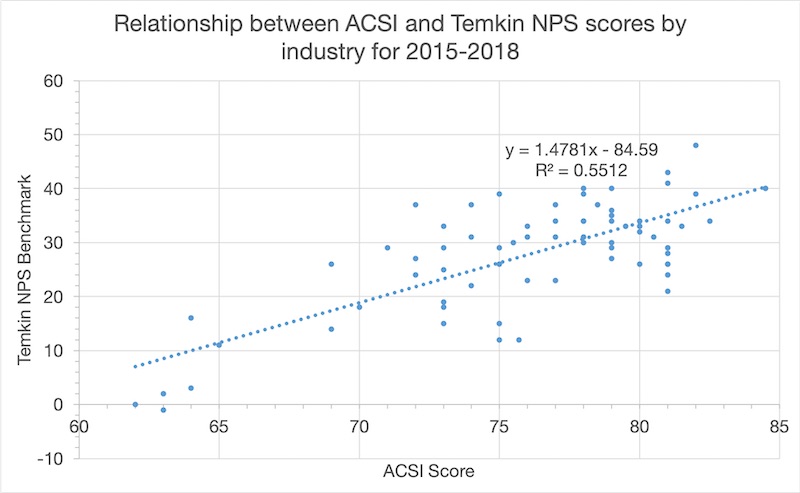Useful if you have no NPS® benchmarks for your company – ACSI to NPS converter
As many of you know, public competitive NPS benchmarks are exceedingly rare. The only large-scale public customer satisfaction data I know of is the American Customer Satisfaction Index. So… the question I asked two years ago is whether it would be better than nothing to design a method of converting an ACSI score into an NPS number. The graph above shows the mathematical relationship between the two numbers. There is some research that supports this approach. And of course, any results are only as good as the sources of the data.
Temkin and ACSI data
Bruce Temkin publishes NPS benchmarks. You have to pay to have the full database. However, the summary by industry is free. The American Customer Satisfaction Index people publish satisfaction benchmarks for hundreds of large US companies that sell to consumers. Access is free, and they also summarize the data by industry sector. So, I took both sets of industry results from 2015 to 2018 and mapped them against each other. It gives the graph at the top of this article. You can see the equation of the trend line too.
Research results that support this approach
The ACSI number is a composite metric based on the answers to three questions in the ACSI survey. A Net Promoter Score is based on the answer a single question, “How likely are you to recommend X to a colleague or friend?” Keiningham, Cooil, Andreassen and Aksoy wrote a paper critical of NPS back in 2007. You can find it here. Among other arguments they show that both ACSI and NPS have similar ability to predict a company’s revenue trends. (Reichheld has never said otherwise. His claim has always been that the recommendation question is the best single-question revenue predictor for most industries.) Since their revenue prediction ability seems to be similar it therefore seems reasonable to expect a conversion equation to be at least somewhat accurate.
Examples
Chick-fil-A has a 2017 ACSI score of 87. Applying the y = 1.4781x – 84.59 equation means they have an approximate NPS of 44. Facebook has an ACSI score of 67. That translates to an approximate NPS of 14.
Conclusion
Is this useful? If you think at least the principle is useful, I would welcome any knowledge you may have about public sources of competitive benchmark NPS data. One important point here is that we need competitive benchmarks, meaning a set of NPS results for multiple companies that has been developed using a single method for all companies covered. This excludes self-announced results for a single company. At the moment, the only defect I see in my current method is that Temkin and ACSI cover an overlapping but different set of companies in each industry.
Please let me know what you think.
Maurice



